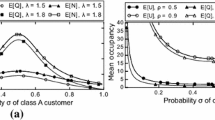Abstract
The capability of modeling non-exponentially distributed and dependent inter-arrival times as well as correlated batches makes the Batch Markovian Arrival Processes (BMAP) suitable in different real-life settings as teletraffic, queueing theory or actuarial contexts. An issue to be taken into account for estimation purposes is the identifiability of the process. This paper explores the identifiability of the stationary two-state BMAP noted as BMAP 2 (k), where k is the maximum batch arrival size, under the assumptions that both the interarrival times and batches sizes are observed. It is proven that for k ≥ 2 the process cannot be identified. The proof is based on the construction of an equivalent BMAP 2(k) to a given one, and on the decomposition of a BMAP 2 (k) into k BMAP 2 (2)s.
Similar content being viewed by others
References
Asmussen S, Koole G (1993) Marked point processes as limits of Markovian arrival streams. J Appl Probab 30:365–372
Blackwell D, Koopmans L (1957) On the identifiability problem for functions of finite Markov chains. Ann Math Stat 28:1011–1015
Bodrog L, Heindlb A, Horvátha G, Telek M (2008) A Markovian canonical form of second-order matrix-exponential processes. Eur J Oper Res 190:459–477
Bookbinder J, Cai Q, He Q M (2011) Shipment consolidation by private carrier: the discrete time and discrete quantity case. Stoch Model 27:664–686
Ephraim Y, Merhav N (2002) Hidden Markov processes. IEEE Trans Inf Theory 48:1518–1569
Falin G I (2010) A single-server batch arrival queue with returning customers. Eur J Oper Res 201:786–790
Gómez-Corral A, Economou A (2007) The batch Markovian arrival process subject to renewal generated geometric catastrophes. Stoch Model 23:211–233
He Q M, Zhang H (2006) PH-invariant polytopes and coxian representations of phase type distributions. Stoch Model 22:383–409
He Q M, Zhang H (2008) An algorithm for computing minimal coxian representations. INFORMS J Comput 20:179–190
He Q M, Zhang H (2009) Coxian representations of generalized Erlang distributions. Acta Math Appl Sin Engl Ser 25:489–502
Heckmüller S, Wolfinger B E (2008) Using load transformations to predict the impact of packet fragmentation and losses on Markovian arrival processes. In: Al-Begain K, Heindl A, Telek M (eds) Proceedings of ASMTA 2008. Springer, Berlin, pp 31–46
Horváth G, Telek M (2007) A minimal representation of Markov arrival processes and a moments matching method. Perform Eval 64:1153–1168
Ito H, Armari S-I, Kobayashi K (1992) Identifiability of hidden Markov information sources and their minimum degrees of freedom. IEEE Trans Inf Theory 38:324–333
Kim B, Kim J (2010) Queue size distribution in a discrete time D−BMAP/G/1 retrial queue. Comput Oper Res 37:1220–1227
Kim C S, Klimenok V I, Orlovskii D S (2008) The BMAP/PH/N retrial queue with Markovian flow of breakdowns. Eur J Oper Res 189:1057–1072
Kim C S, Klimenok V I, Mushko V, Dudin A (2010) The BMAP/PH/N retrial queueing system operating in Markovian random environment. Comput Oper Res 37:1228–1237
Klemm A, Lindemann C, Lohmann M (2002) Traffic modeling of IP networks using the batch Markovian arrival process. In: Field T, Harrison P, Harder U (eds) Computer performance evaluation/tools 2002. Springer, London, pp 92–110
Kriege J, Buchholz P (2010) An empirical comparison of MAP fitting algorithms. In: Muller-Clostermann B, Echtle K, Rathgeb EP (eds) Lecture notes in computer science. Springer, Berlin, pp 259–273
Leroux B (1992) Maximum-likelihood estimation for hidden Markov models. Stoch Process Appl 40:127–143
Lucantoni D (1991) New results on the single server queue with a batch Markovian arrival process. Stoch Model 7:1–46
Lucantoni D (1993) The BMAP/G/1 queue: a tutorial. In: Donatiello L, Nelson R (eds) Models and techniques for performance evaluation of computer and communications systems. Springer, Berlin, pp 330–358
Neuts M F (1975) Probability distributions of phase type. In: Holvoet R, Florin H (eds) Liber Amicorum Prof. Emeritus H. Florin. University of Louvain, Belgium, pp 173–206
Neuts M F (1979) A versatile Markovian point process. J Appl Probab 16:764–779
Niyato D, Hossain E, Fallahi A (2007) Sleep and wakeup strategies in solar-powered wireless sensor/mesh networks: performance analysis and optimization. IEEE Trans Mobile Comput 6:221–236
O ́Cinneide C (1990) On nonuniqueness of representations of phase-type distributions. Commun Stat - Stoch Model 5:247–259
Ramírez-Cobo P, Lillo R (2011) New results about weakly equivalent MAP2 and MAP3 processes. Methodol Comput Appl Probab 14:421–444
Ramírez-Cobo P, Lillo R, Wiper M (2010) Non identifiability of the two-state Markovian arrival process. J Appl Probab 46:630–649
Rydén T (1994) Consistent and asymptotially normal parameter estimates for hidden Markov models. J Ann Stat 22:1884–1895
Rydén T (1996) On identifiability and order of continuous-time aggregated Markov chains, Markov-modulated Poisson processes, and phase-type distributions. J Appl Probab 33:640–653
Author information
Authors and Affiliations
Corresponding author
Additional information
Research partially supported by research grants and projects ECO2011-25706, ECO2012-38442 and MTM2009-14039 (Spanish Ministry of Science and Innovation), P11-FQM-7603 and FQM329 (Junta de Andalucía, Spain). The third author was supported by Consolider “Ingenio Mathematica” through her post-doc contract.
Rights and permissions
About this article
Cite this article
Rodríguez, J., Lillo, R.E. & Ramírez-Cobo, P. Nonidentifiability of the Two-State BMAP . Methodol Comput Appl Probab 18, 81–106 (2016). https://doi.org/10.1007/s11009-014-9401-z
Received:
Revised:
Accepted:
Published:
Issue Date:
DOI: https://doi.org/10.1007/s11009-014-9401-z
Keywords
- Batch Markovian Arrival Process (BMAP)
- Identifiability problems
- Hidden Markov models
- Redundant representations




